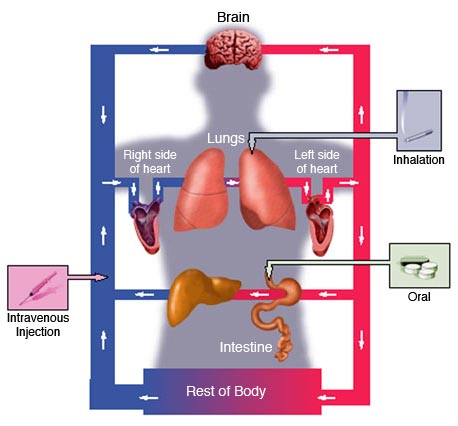Learning the science behind cocaine, drug testing, and nerve gas can help high school students understand basic biology and chemistry concepts, a NIDA-funded study has found. Test scores of students who were exposed to drug-related modules in science classrooms were higher than scores of students whose science classes did not include the modules.

In an unusual research alliance, Dr. Rochelle Schwartz-Bloom, a pharmacology professor at Duke University Medical Center in Durham, North Carolina, and Dr. Myra Halpin, a high school chemistry teacher at the North Carolina School of Science and Mathematics, also in Durham, developed and tested a novel science curriculum founded on the idea that teenagers will learn more if they perceive the course content as relevant to their lives. The project, called the Pharmacology Education Partnership (PEP), is supported by a NIDA Science Education Drug Abuse Partnership Award (SEDAPA). The SEDAPA grant program funds the development and evaluation of innovative model programs and materials to enhance knowledge of neuroscience and the biology of drug abuse and addiction among K-12 students, their parents, and other groups.
The PEP curriculum used in the study included four modules that biology and chemistry teachers integrated into their normal curricula. Three of the modules covered the biological and chemical aspects of abused drugs and drug testing, and the fourth module discussed the science of nerve gas. The modules were built around drug topics, but each module was designed to teach standard high school science content, such as molecular structure, cellular structure, anatomy, physiology, oxidation and reduction, and enzyme action.
"Getting kids interested and holding their attention is the most important thing in teaching," explains Dr. Schwartz-Bloom, the study's principal investigator. "If you can't do that, then students will learn very little. Whether you are teaching about drug abuse or something else, using topics that fascinate this population gets their attention so they want to learn."
Dr. Cathrine Sasek, NIDA's science education coordinator, observes that the PEP curriculum takes an innovative teaching approach. "It doesn't bring the kids in and say, 'Okay, today we're talking about drug abuse.' Instead, it teaches biology, chemistry, and biochemistry concepts kids need to learn, using drugs as examples," she says. "In addition, it allows teachers to tailor the curriculum, which immediately has appeal for them."
Dr. Schwartz-Bloom and Dr. Halpin designed the PEP curriculum and then measured how well teaching with the modules stacked up against teaching with schools' usual biology and chemistry curricula. Pairs of experienced biology and chemistry teachers from 25 high schools nationwide were recruited to learn how to use the PEP modules and to field-test the modules in their classrooms. The teachers were randomly assigned to either an experimental group or a control group.
In the first year, teachers for the experimental groups attended a 1-week summer workshop at Duke University to learn basic pharmacology and to design classroom activities that would reinforce the PEP module content. They incorporated the modules and activities into their teaching during the following school year. Each teacher was encouraged to use as many of the four modules as possible, but the investigators did not prescribe methods for using the modules or the number of modules to use.
 This image, developed for a PEP module entitled "Acids, Bases and Cocaine Addicts," depicts the three most common modes of drug administration and how the drug then moves through the . The red outline is the arterial side of the heart; blue is the venous side.
This image, developed for a PEP module entitled "Acids, Bases and Cocaine Addicts," depicts the three most common modes of drug administration and how the drug then moves through the . The red outline is the arterial side of the heart; blue is the venous side.The control group attended the same workshop the next summer and then integrated the PEP modules into their teaching during the following school year. This wait-listed strategy allowed the researchers to rule out the possibility that the experimental group included better teachers, despite random assignment.
At the end of year one, both the experimental and control group teachers gave their students a brief, unannounced, multiple-choice test to assess their knowledge of biology and chemistry facts and concepts as well as their science reasoning skills. "Basic knowledge" questions addressed knowledge and skills contained in the National Science Education Standards, and "advanced knowledge" questions targeted new drug knowledge obtained from the teaching modules. At the end of year two, the same test was given to students in the current experimental groups after the teachers had used the modules in their classrooms. Nationwide, more than 4,000 students in grades 9 through 12 took the end-of-course tests over the 2 years.
Use of the PEP modules was significantly associated with students' end-of-course test scores for both the basic and advanced knowledge questions. As the number of PEP modules used in the classroom increased, so too did the students' test scores. On average, students scored 6, 12, and 20 percentage points higher on the basic knowledge questions when two, three, and four modules were used, respectively, than when no modules were used. Similarly, for the advanced knowledge questions, students scored 6, 11, and 28 percentage points higher when two, three, and four modules were used, respectively, compared with no use of modules.
Dr. Schwartz-Bloom likens these findings to a dose-response relationship seen in pharmacology. "The bigger the dose, the bigger the effect," she says, adding that the increment in test scores as more modules were used may have resulted from the repetition built into the modules "to keep driving home basic biology and chemistry concepts."
 Students' Biology and Chemistry Knowledge Increases With Number of PEP Modules Teachers Use. The PEP modules incorporated drug abuse and addiction topics into high school biology and chemistry curricula. Using topics of interest to students helped increase their mastery of basic and advanced biology and chemistry concepts. The surprise test included biology and chemistry questions, but many of the students had taken biology only.
Students' Biology and Chemistry Knowledge Increases With Number of PEP Modules Teachers Use. The PEP modules incorporated drug abuse and addiction topics into high school biology and chemistry curricula. Using topics of interest to students helped increase their mastery of basic and advanced biology and chemistry concepts. The surprise test included biology and chemistry questions, but many of the students had taken biology only.The researchers further note that in classes where two or more modules were used, students were able to answer both biology and chemistry questions correctly, regardless of whether they were enrolled in biology or chemistry classes. Dr. Schwartz-Bloom asserts that this finding is interesting, particularly because interdisciplinary teaching is now of great interest in science education. "The interdisciplinary nature of the design really worked," she says. "We got the biology kids to learn chemistry and we got the chemistry kids to really beef up on biology. That was icing on the cake."
Additionally, the investigators found that the PEP project benefited the teachers, who received training and professional development during the summer workshops at Duke University. Tests given to the teachers before and after the workshops showed significant gains in their knowledge of biology, chemistry, and pharmacology—and that many of them had retained the knowledge when tested a year later.
"The amount of information the teachers retained was very impressive," Dr. Sasek notes. "The teachers are using what they learned and are retaining it, which is really important." Since completing the initial 4-year PEP study, Drs. Schwartz-Bloom and Halpin have been awarded a second SEDAPA grant to continue their work. The new funding has allowed them to create two new PEP modules and to develop an interactive Web site that provides access to the teaching modules and lets teachers and students input data. The site is www.thepepproject.net. The new grant also will enable the researchers to expand the number of students tested to 16,000—a sample size large enough to permit reliable analysis of the data by race and gender.
Source
- Schwartz-Bloom, R.D., and Halpin, M.J. Integrating pharmacology topics in high school biology and chemistry classes improves performance. Journal of Research in Science Teaching 40(9):922-938, 2003. [Abstract]
